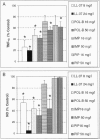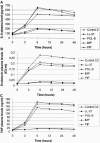LL-37 protects rats against lethal sepsis caused by gram-negative bacteria
- PMID: 16641434
- PMCID: PMC1472226
- DOI: 10.1128/AAC.50.5.1672-1679.2006
LL-37 protects rats against lethal sepsis caused by gram-negative bacteria
Abstract
We investigated the efficacy of LL-37, the C-terminal part of the only cathelicidin in humans identified to date (termed human cationic antimicrobial protein), in three experimental rat models of gram-negative sepsis. Adult male Wistar rats (i) were given an intraperitoneal injection of 1 mg Escherichia coli 0111:B4 LPS, (ii) were given 2 x 10(10) CFU of Escherichia coli ATCC 25922, or (iii) had intra-abdominal sepsis induced via cecal ligation and puncture. For each model, all animals were randomized to receive intravenously isotonic sodium chloride solution, 1-mg/kg LL-37, 1-mg/kg polymyxin B, 20-mg/kg imipenem, or 60-mg/kg piperacillin. Lethality; growth of bacteria in blood, peritoneum, spleen, liver, and mesenteric lymph nodes; and endotoxin and tumor necrosis factor alpha (TNF-alpha) concentrations in plasma were evaluated. All compounds reduced lethality compared to levels in controls. Endotoxin and TNF-alpha plasma levels were significantly higher in conventional antibiotic-treated rats than in LL-37- and polymyxin B-treated animals. All drugs tested significantly reduced bacterial growth compared to saline treatment. No statistically significant differences between LL-37 and polymyxin B were noted for antimicrobial and antiendotoxin activities. LL-37 and imipenem proved to be the most effective treatments in reducing all variables measured. Due to its multifunctional properties, LL-37 may become an important future consideration for the treatment of sepsis.
Figures



References
-
- Akashi, S., S. Saitoh, Y. Wakabayashi, T. Kikuchi, N. Takamura, Y. Nagai, Y. Kusumoto, K. Fukase, S. Kusumoto, Y. Adachi, A. Kosugi, and K. Miyake. 2003. Lipopolysaccharide interaction with cell surface Toll-like receptor 4-MD-2: higher affinity than that with MD-2 or CD14. J. Exp. Med. 198:1035-1042. - PMC - PubMed
-
- Angus, D. C., W. T. Linde-Zwirble, J. Lidicker, G. Clermont, J. Carcillo, and M. R. Pinsky. 2001. Epidemiology of severe sepsis in the United States: analysis of incidence, outcome, and associated costs of care. Crit. Care Med. 29:1303-1310. - PubMed
-
- Boman, H. G. 2003. Antibacterial peptides: basic facts and emerging concepts. J. Int. Med. 254:197-215. - PubMed
-
- Bone, R. C. 1991. Pathophysiology of sepsis. Ann. Intern. Med. 115:457-469. - PubMed
Publication types
MeSH terms
Substances
LinkOut - more resources
Full Text Sources
Other Literature Sources
Medical

